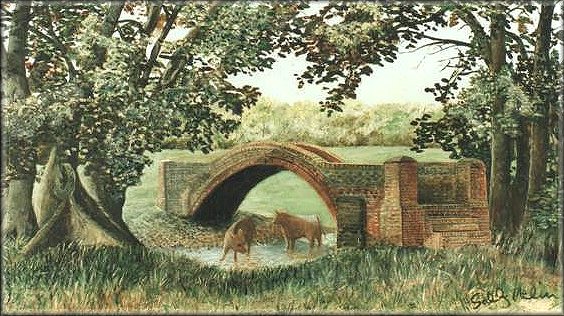The Chinese Bridge

The Chinese Bridge (Painting by Sally Helm)
THE ENIGMA THAT IS "THE CHINESE
BRIDGE.
When was it built? Who was responsible for its building? Why so called?
Many of the older generation of the village have recalled playing as
children near to this bridge located south of Henley Park Mansion and spanning
the stream that flows north from Tickner's Bridge through the low meadows
of Henley Park eastwards towards the road bridge at Cobbetts Hill Road.
Some referred to it as "Cheynie's Bridge", others as
"The China Bridge", but most referred to it as "The
Chinese Bridge", presumably because of the bridge associated with
that shown on the Willow Pattern table-ware popular in the early 1900s.
This ornamental bridge, built in red brick with red paved-brick footing,
is an extraordinary feature of the meadows, providing a footbridge crossing
to the stream for the public footpath that links the upland fields of Henley
Park Farm to the water meadows of the lowland fields abutting the Guildford
- Aldershot A323 Road. An inspection of the brickwork leads to the conclusion
that much of the originality of the structure has been retained but repair
and modifications are apparent at both approaches and some of the brick
decking.
Buttresses on either side of the stream support a high arch, surmounted
longitudinally by parapets about 18 inches high raised on either side of
the walk-way. John Baker, well known local artist whose work was frequently
shown in the Surrey Advertiser, described it as a 'sheep bridge', possibly
because a shepherd could stand astride of the parapets of the bridge as
the sheep passed beneath him to be counted; but as practicable as that
would appear to be, it would hardly account for the construction and placing
of such an elaborate structure in that locality.
The Ordnance Survey of c1870 indicates a footbridge (f b.) but of course
no description of the type of bridge is given, but perhaps the field notes
of the Surveyors (if available) might be more descriptive. Of interest
on this OS map is an adjoining stream and water-way named "Withy Bed
Copse", now severely neglected but still discernable as having been
well cared for at one time. A search of the area in March 2004 revealed
that the water source appears to be a low volume spring to the west rising
at the foot of a very old oak tree of approximately 150 years of age. The
westerly water, with an elongated island supporting a mass of old willow
trees, is joined to the easterly water by a sluice, from which a small
flow trickled into the easterly water via a conduit.
The 6" OS map of 1896 indicates that the footbridge of 1870 is
now credited with a sluice, but there would appear to be no evidence of
this during the search of March 2004. Furthermore the map gives "fish
ponds" for the previous name of Withy Bed Copse. The OS map of 1915
reverts to "footbridge" for the location of The Chinese Bridge.
At present there is no definitive date of build or who was responsible
for its construction but supposition suggests that it was constructed for
the benefit of gentlemen visitors to the Mansion so that they could more
leisurely and more thoroughly enjoy the excellent hunting, shooting and
fishing provided by Lord Pirbright. This supposition pre-supposes further
that it might well have been during the early tenancy of Henley Park by
Lord Pirbright, possibly in the 1890s, when he made many beautifying improvements
to the Mansion and to the estate particularly for the benefit of visitors
of Royal rank. Peter Blakiston |